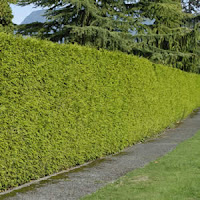Prunus Laurocerasus Rotundifolia - cherry laurel - They bear glossy dark green foliage , small delicate white flowers and shiny cherry red berries. The Cherry Laurel is commonly used as a hedging plant as it is fast growing and forms a lovely bushy evergreen screen. It is also tolerant to a large variety of soil and sunlight conditions making it ideal for most gardens.
Planting your laurels
Planting your laurels
- Decide how far apart you want to space your laurels and then dig a hole which is the height and twice the width of the rootball. Break up the compacted soil from the bottom of the hole. Laurels grow very quickly so can be generously spaced as they will quickly form a dense bushy hedge.
- Place the plants rootball into the hole and fill the hole with a mixture of soil and organic fertilizer. Gently compact the soul to support the plant.
- Water the Laurel regularly throughout it's first year to allow the plant to establish itself well into it's new home.
Once the Laurels are established (you will know when this is as new growth will appear) you will be able to start trimming them. It is best to prune laurels over the summer months between April and August.
- If you want the new growth to be in a certain area, simply cut back the branch so only a couple of leaves remain. A new shoot will appear within a few weeks. Keep doing this until you have created a good canopy and have created your desired shape.
- Once you have your perfect shape, all you need to do is keep your hedge neat and tidy by trimming back individual branches as and when with a sharp pair of secateurs.
Would you like to purchase high quality, reasonably priced laurels? Click here to take a look at our website.









